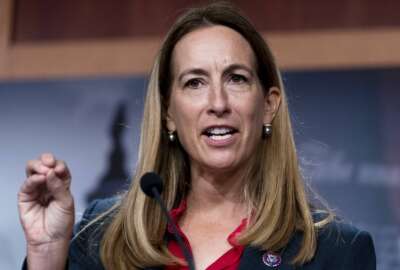Senate leaders to attempt a compromise as shutdown looms
Time for lawmakers to pass a continuing resolution is running short as the fiscal year ends Friday. The Senate rejected the House version of CR Friday, and will...
wfedstaff | June 4, 2015 12:05 pm
The Senate late Monday afternoon will take up its version of the continuing resolution that will keep the government open through Nov. 18. Democratic leaders hope the weekend respite will have led to some progress in finding common ground on how to pay for billions in disaster relief aid.
“My suggestion to my friend is that the two Democratic leaders, [Harry] Reid and [Nancy] Pelosi, and the two Republican leaders, [Mitch] McConnell and [John] Boehner, should just cool off for a little bit and work through this,” said Sen. Harry Reid (D-Nev.), the majority leader, on Friday after the Senate rejected the House bill.
“There is a compromise here,” he said. “The compromise is now before the Senate. Everyone once in while needs a little cooling off period. The government is not shutting down. I spoke to Mr. [Craig] Fugate myself — FEMA is not running out of money. We will come here Monday and more reasonable heads will prevail and I hope over the weekend the four leaders can lead their troops in the right direction.”
The House passed its version of the CR early Friday morning. It included $3.7 billion for FEMA’s disaster relief fund.
The Senate rejected the bill Friday because of how the House wanted to pay for the additional spending — through an environmental loan program run by the Energy Department to subsidize low-interest loans to help car companies and parts manufacturers retool factories to meet new fuel economy standards.
The upper chamber initially provided $6.9 billion in disaster aid and no cuts to help pay for it as part of an appropriations bill passed last week.
FEMA said its disaster relief fund has less than $200 million and could run out in the coming week. With fiscal 2011 ending Friday, the House doesn’t plan to convene next week to take up another version of the bill. Therefore, the Senate could accept the House bill it rejected on Friday. Or legislative leaders could try to negotiate their way past the logjam.
Cuts in 2012 becoming clearer
In the meantime, the Senate continues to work on fiscal 2012 spending bills. And two specific cuts already are getting push back.
Members of the Senate Homeland Security Committee pledged to get money put back into the Government Accountability Office’s budget after the Appropriations Committee cut it by 8 percent in the Legislative spending bill.
GAO would receive about $42 million less than it did in 2011and $52 million less than the White House’s 2012 request — for a total of $504 million.
“The very tool this committee and all its subcommittees use the most is GAO,” said Sen. Tom Coburn (R-Okla.), during a recent committee hearing. “I’m not going to question the appropriations committee move, but it’s certainly a wrong-headed move by the committee.”
Coburn received a lot of support from fellow lawmakers. Sen. Tom Carper (D-Del.) said jokingly that each of the member’s offices should take up a collection for GAO.
Sen. Joseph Lieberman (I-Conn.) said he would try to get the funding put back in on the Senate floor during debate over the bill.
The Senate Appropriations Committee passed the Financial Services and General Government bill and decided to combine the E-Government Fund with the Federal Citizen Services Fund and call it the Information and Engagement for Citizens fund.
Lawmakers decided to allocate the new Information and Engagement for Citizens Fund a total of $39 million.
The President requested $34 million for the E-Government Fund for 2012 and requested another $39 million for the Federal Citizen Services Fund. The new fund is about half of the request for both funds.
Stopping e-government duplication
The Senate Appropriations Committee wrote in the report on the bill that these funds share a common objective — making it easier for citizens to understand and interact with their government. “The purpose of this new office is to provide electronic or other methods of providing access and understanding of federal information, benefits, and services to citizens, businesses, other governments, and the media,” the committee wrote.
A committee spokesman said the proposed 2012 funding is only about $2 million less than the 2011 total funding for both programs combined. Congress approved $7.9 million for the E-Government Fund and $34 million for the Federal Citizen Services Fund.
Dave McClure, the associate administrator in the General Services Administration’s Office of Citizen Services and Innovative Technologies, told a House committee earlier in the week that the cut in funding will have a negative effect on the projects that the E-Government fund supports such as Data.gov, the IT Dashboard and many others.
“When anyone gets less money than requested something has got to give,” McClure said. “So that’s our challenge, we are trying to use this fund to fuel innovation, to do cross agency governmentwide work, not single agency work, this is not GSA money. If we reduce funding levels down to those levels you will have operations and maintenance work going on on existing projects rather than fueling new, creative ways to save money for the government.”
Lieberman, who authored the E-Government Act of 2002 that created the fund, said he can accept the need to combine the two funds, but isn’t happy about the cuts in total funding.
“The cuts in the funding will hamper the effectiveness of programs that return much more than they cost,” he said.
Varying degree of e-gov success
The merging of and the cuts to the E-Government Fund come as GAO issued its latest report on how GSA and the Office of Management and Budget spent the 2010 appropriations.
OMB and GSA spent $34 million across 16 projects and six functional areas, including $10 million on a range of projects from cloud computing security guidance, known as FedRAMP to data center inventory and consolidation planning to improving the functionality of data.gov.
GAO analyzed the progress of four projects — FedRAMP, Citizen Services Dashboard, FedSpace and Data.gov — made varying progress toward their goals.
“For example, a cloud computing security initiative was still being developed; a dashboard for displaying target and actual customer service metrics had been developed in a pilot with four agencies, but had not been publicly released; a platform for government employees and contractors to use Web-based networking and collaboration tools was in limited deployment; and a website (Data.gov) that allows the public to find, download and use government-generated data had been fully launched,” auditors said.
Former federal chief information officer Vivek Kundra terminated FedSpace and the Citizen Services Dashboard in May after Congress cut E-Government funding by 76 percent.
In June, GSA told GAO they could not find a way for agencies to fund these two programs collaboratively and therefore would take them offline and store the software for possible use in the future.
GAO also found the other two projects “do not yet have fully defined metrics that align with all of their major goals and intended benefits. Thus, managers and stakeholders cannot effectively assess project results and provide credible evidence of progress, which is particularly important in a resource-constrained environment.”
GAO recommended GSA ensure it has fully defined the metrics for the remaining programs.
RELATED STORIES:
Senate kills short-term continuing resolution
OMB prepares for open gov sites to go dark in May
Budget cuts shutter two open gov sites, others impacted
Will E-Gov merger lead to reduction in services?
Copyright © 2025 Federal News Network. All rights reserved. This website is not intended for users located within the European Economic Area.
Jason Miller is executive editor of Federal News Network and directs news coverage on the people, policy and programs of the federal government.
Follow @jmillerWFED






